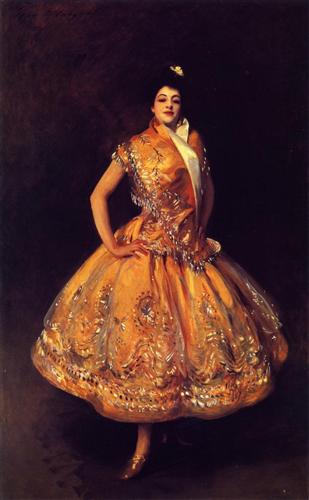John Singer Sargent's Intimate Portraits of Artists and Friends: Witty and Radical

The exhibition, Sargent: Portraits of Artists and Friends, shown until 25 May 2015, explores the artist as a painter at the forefront of contemporary movements in the arts, music, literature and theater, revealing the depth of his appreciation of culture and his close friendships with many of the leading artists, actors and writers of the time.
La Carmencita (left), by John Singer Sargent, c 1890. Photograph: National Portrait Gallery, London
Ellen Terry as Lady Macbeth (right) by John Singer Sargent. Oil on Canvas, Collection: Tate
Bringing together remarkable loans, some rarely exhibited, from galleries and private collections in Europe and America, the exhibition will follow Sargent's time in Paris, London and Boston as well as his travels in the Italian and English countryside. Musée Rodin, the Fine Arts Museums of San Francisco, Musée d'Orsay, the Art Institute of Chicago and the Minneapolis Institute of Arts are amongst the institutions that are lending works.
Sargent's portraits of his friends and contemporaries were rarely commissioned and allowed him to create more experimental works than was possible in his formal portraiture. His sitters are depicted in informal poses, sometimes in the act of painting or singing, resulting in a collection of highly-charged, original portraits. These paintings form a distinctive strand in Sargent's work which is noticeably more intimate, witty and radical, and, when brought together in the exhibition, will challenge the conventional view of the artist.
Key exhibits include the only two surviving portraits Sargent painted of his friend and novelist Robert Louis Stevenson, which will be displayed together for the first time since they were painted in the 1880s. Also reunited in the exhibition will be Sargent's portraits of the Pailleron family, drawn from collections in Paris, Washington DC and Iowa. The bohemian writer Édouard Pailleron and his wife were among Sargent's earliest French patrons, and to whom the young artist owed much of his early success. Their individual portraits will be displayed alongside Sargent's portrait of their children, Édouard and Marie-Louise, for the first time in over a century.
Other exhibition highlights include Sargent’s important portrait of his master Carolus-Duran (1879), which played a pivotal role in the development of his career after it was praised in the 1879 Paris Salon; his charcoal drawing of the celebrated poet William Butler Yeats (1908); and three of his greatest theatrical portraits painted between 1889 and 1890: Ellen Terry as Lady Macbeth, Edwin Booth and La Carmencita, the wild Spanish dancer.
Two sections in the exhibition will focus on the portraits and plein-air figure scenes he painted during time spent in the artistic community in the village of Broadway in rural Worcestershire, and those he painted after 1900 on his travels to the Alps and southern Europe. Sitters include Sargent’s familiars such as the artists Jane and Wilfred de Glehn who accompanied him on his sketching expeditions to the continent and often feature as a pair in his work. In these paintings Sargent explored the making of art (his own included) and the relationship of the artist to the natural world.
Pages: 1 · 2







